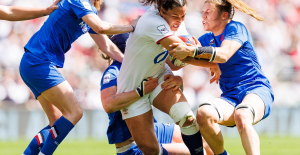Tiny water particles and dust grains play the decisive role when it comes to the formation of snowflakes. What these ultimately look like depends on many things. The fact check.
Rating: Correct. However, the basic forms can be similar.
Facts: It is actually impossible for two snowflakes to form exactly the same in nature. Because there are many factors that influence what a flake looks like.
A snowflake is made up of many tiny ice particles. According to the German Weather Service (DWD), these can arise in two ways in the clouds. Either pure water vapor freezes directly into ice particles in very cold air. To do this, however, it has to be very cold in the cloud, close to minus 40 degrees Celsius. The normal case: water particles freeze on dust grains with which they meet in the cloud. This is how tiny ice crystals form. More water particles freeze at their corners and the crystals grow – snowflakes are formed. At some point they are so heavy that they fall from the sky.
On the way to the snowflake, the ice crystals gradually turn into prisms, columns, small plates, needles or snow stars. The ice crystals are initially only a few micrometers in size and almost always have a hexagonal shape, explains DWD meteorologist Sebastian Altnau. The reason for the basic structure lies in the arrangement of the water molecules. Because of the myriad ways in which molecules can come together, it is believed that no two crystals are alike.
One of the best-known publications goes back to an autodidact. The American Wilson Bentley showed more than 2400 photographs of snow crystals in his book "Snow Crystals" from 1931. With the "delicate beauties", as the DWD calls them, Bentley unleashed a wave of enthusiasm.
In Japan, the physicist Ukichiro Nakaya continued his research at the University of Hokkaido from 1933. According to DWD information, he shot around 3,000 photos of natural ice crystals. Based on their appearance, he divided them into 41 basic forms with seven main types. In other words, the closer you look at a snowflake, the more unique it is. The graphic work of the Japanese is still known in specialist literature today as the "Nakaya diagram".
The snowflake is further formed and constantly changed on its one to three hour journey from the clouds to the earth. Researcher Nakaya found that the shape of snow crystals depends on atmospheric conditions. Above all, the temperature and humidity of the air influence the later shape.
While at minus 15 degrees Celsius, according to DWD expert Altnau, “particularly shapely specimens” develop, ice columns, needles or prisms tend to form at minus seven degrees Celsius. Humidity also plays a fundamental role. Nakaya also recognized that the complexity of the structure of the crystals increases with increasing water vapor content in the air and that they therefore form more filigree structures.
For ice crystals to start forming, at least 275 water molecules must connect. Scientists from Göttingen found this out. A crystal visible to the human eye then already contains around one trillion molecules - a 1 followed by 18 zeros. Many crystals hook together to form a snowflake, which can vary in size depending on the weather. The general rule is: the milder the sub-zero temperature, the more likely it is that larger flakes will be possible. The Guinness Book has the record at 38 centimeters wide - sighted in 1887 by a farmer in the USA. If that's true? Who knows.
"Aha! Ten minutes of everyday knowledge" is WELT's knowledge podcast. Every Tuesday and Thursday we answer everyday questions from the field of science. Subscribe to the podcast on Spotify, Apple Podcasts, Deezer, Amazon Music, among others, or directly via RSS feed.

 B:SM will break its investment record this year with 62 million euros
B:SM will break its investment record this year with 62 million euros War in Ukraine: when kyiv attacks Russia with inflatable balloons loaded with explosives
War in Ukraine: when kyiv attacks Russia with inflatable balloons loaded with explosives United States: divided on the question of presidential immunity, the Supreme Court offers respite to Trump
United States: divided on the question of presidential immunity, the Supreme Court offers respite to Trump Maurizio Molinari: “the Scurati affair, a European injury”
Maurizio Molinari: “the Scurati affair, a European injury” First three cases of “native” cholera confirmed in Mayotte
First three cases of “native” cholera confirmed in Mayotte Meningitis: compulsory vaccination for babies will be extended in 2025
Meningitis: compulsory vaccination for babies will be extended in 2025 Spain is the country in the European Union with the most overqualified workers for their jobs
Spain is the country in the European Union with the most overqualified workers for their jobs Parvovirus alert, the “fifth disease” of children which has already caused the death of five babies in 2024
Parvovirus alert, the “fifth disease” of children which has already caused the death of five babies in 2024 Inflation rebounds in March in the United States, a few days before the Fed meeting
Inflation rebounds in March in the United States, a few days before the Fed meeting Video games: Blizzard cancels Blizzcon 2024, its annual high mass
Video games: Blizzard cancels Blizzcon 2024, its annual high mass Falling wings of the Moulin Rouge: who will pay for the repairs?
Falling wings of the Moulin Rouge: who will pay for the repairs? “You don’t sell a company like that”: Roland Lescure “annoyed” by the prospect of a sale of Biogaran
“You don’t sell a company like that”: Roland Lescure “annoyed” by the prospect of a sale of Biogaran Exhibition: in Deauville, Zao Wou-Ki, beauty in all things
Exhibition: in Deauville, Zao Wou-Ki, beauty in all things Dak’art, the most important biennial of African art, postponed due to lack of funding
Dak’art, the most important biennial of African art, postponed due to lack of funding In Deadpool and Wolverine, Ryan and Hugh Jackman explore the depths of the Marvel multiverse
In Deadpool and Wolverine, Ryan and Hugh Jackman explore the depths of the Marvel multiverse Tom Cruise returns to Paris for the filming of Mission Impossible 8
Tom Cruise returns to Paris for the filming of Mission Impossible 8 Skoda Kodiaq 2024: a 'beast' plug-in hybrid SUV
Skoda Kodiaq 2024: a 'beast' plug-in hybrid SUV Tesla launches a new Model Y with 600 km of autonomy at a "more accessible price"
Tesla launches a new Model Y with 600 km of autonomy at a "more accessible price" The 10 best-selling cars in March 2024 in Spain: sales fall due to Easter
The 10 best-selling cars in March 2024 in Spain: sales fall due to Easter A private jet company buys more than 100 flying cars
A private jet company buys more than 100 flying cars This is how housing prices have changed in Spain in the last decade
This is how housing prices have changed in Spain in the last decade The home mortgage firm drops 10% in January and interest soars to 3.46%
The home mortgage firm drops 10% in January and interest soars to 3.46% The jewel of the Rocío de Nagüeles urbanization: a dream villa in Marbella
The jewel of the Rocío de Nagüeles urbanization: a dream villa in Marbella Rental prices grow by 7.3% in February: where does it go up and where does it go down?
Rental prices grow by 7.3% in February: where does it go up and where does it go down? Even on a mission for NATO, the Charles-de-Gaulle remains under French control, Lecornu responds to Mélenchon
Even on a mission for NATO, the Charles-de-Gaulle remains under French control, Lecornu responds to Mélenchon “Deadly Europe”, “economic decline”, immigration… What to remember from Emmanuel Macron’s speech at the Sorbonne
“Deadly Europe”, “economic decline”, immigration… What to remember from Emmanuel Macron’s speech at the Sorbonne Sale of Biogaran: The Republicans write to Emmanuel Macron
Sale of Biogaran: The Republicans write to Emmanuel Macron Europeans: “All those who claim that we don’t need Europe are liars”, criticizes Bayrou
Europeans: “All those who claim that we don’t need Europe are liars”, criticizes Bayrou These French cities that will boycott the World Cup in Qatar
These French cities that will boycott the World Cup in Qatar Euroleague: at the end of the suspense, Monaco equalizes against Fenerbahçe
Euroleague: at the end of the suspense, Monaco equalizes against Fenerbahçe Women's Six Nations: Where to see and five things to know about France-England
Women's Six Nations: Where to see and five things to know about France-England Liverpool: it is confirmed, Slot will succeed Klopp on the Reds bench
Liverpool: it is confirmed, Slot will succeed Klopp on the Reds bench Ligue 1: Montpellier and Nantes back to back, two reds in stoppage time
Ligue 1: Montpellier and Nantes back to back, two reds in stoppage time


















